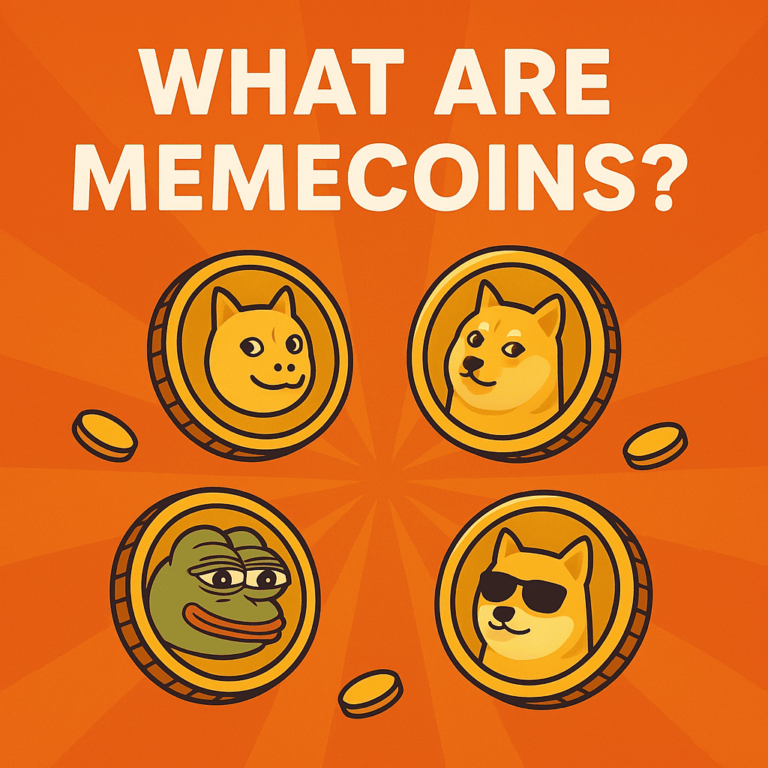In the ever-evolving world of cryptocurrency, a bizarre phenomenon has taken center stage: memecoins. These are tokens inspired not by deep technical innovation or whitepapers—but by jokes, internet culture, and viral memes. And yet, they often outperform so-called “serious” projects in both returns and visibility. Let’s dive into what they are, why they exist, how to buy them, and how they’ve become one of the most controversial—and entertaining—parts of the crypto ecosystem.
What Is a Memecoin?
A memecoin is a type of cryptocurrency that originated as a parody or joke, often inspired by internet memes, cultural references, or satirical takes on the crypto industry itself. The most famous examples are Dogecoin and Shiba Inu, but countless others now flood the market—like PEPE, Floki, and Wojak.
Unlike traditional cryptocurrencies which are typically launched with specific use-cases or blockchain innovations, memecoins tend to be community-driven, humor-laden, and virality-focused. They often lack technical utility or long-term roadmaps, yet they thrive on hype, social media, and celebrity endorsement.
Where Did Memecoins Come From?
The first notable memecoin was Dogecoin, launched in 2013 by Billy Markus and Jackson Palmer. Based on the Shiba Inu “Doge” meme, it was intended as a lighthearted alternative to Bitcoin. To everyone’s surprise, it gained traction. By 2021, thanks to TikTok challenges and Elon Musk’s tweets, Dogecoin reached a market cap of over $80 billion.
Why Do People Buy Memecoins?
- Virality & Hype: Memecoins are the financial embodiment of going viral. People don’t buy them for fundamentals; they buy them because “everyone else is.”
- Low Entry Price: Most memecoins are priced at fractions of a cent, which makes them psychologically appealing. $100 can buy millions of tokens—creating the illusion of outsized potential.
- Community Culture: Memecoins often have passionate, meme-savvy communities. They create viral content, memes, and run grassroots campaigns to increase exposure.
- Speculation: Many investors gamble on memecoins in hopes of finding the next Dogecoin. Some people have made millions overnight—many more have lost everything.
Do Memecoins Have Any Utility?
This is a heavily debated topic. Technically, most memecoins lack clear utility. They’re rarely used for payments or dApps. However, their real “utility” lies in social signaling, speculation, and community bonding. A few projects have tried to introduce staking, NFTs, or metaverse tie-ins—but success remains rare.
The Risks of Investing in Memecoins
- Lack of Fundamentals: Most memecoins are not tied to any underlying project or utility.
- Extreme Volatility: Memecoin prices can skyrocket in hours—and crash just as quickly.
- Pump-and-Dump Schemes: Many tokens are created with the sole intent of making early buyers rich at the expense of later investors.
- Rug Pulls: Developers can abandon projects, pull liquidity, or manipulate tokenomics without notice.
Popular Memecoins to Know
- Dogecoin (DOGE): The original memecoin, supported by Elon Musk and used by some retailers for payments.
- Shiba Inu (SHIB): Launched as a Dogecoin “killer,” SHIB built a massive ecosystem including a decentralized exchange and NFT projects.
- Pepe (PEPE): Based on the controversial frog meme. Purely community-driven and highly speculative.
- Floki Inu (FLOKI): Inspired by Elon Musk’s Shiba Inu named Floki. Like others, it thrives on community and marketing.
How to Buy Memecoins
Buying memecoins can be easy—or incredibly risky—depending on the coin’s popularity and platform availability. Here’s a step-by-step guide:
- Choose a Crypto Exchange: Start with a reputable exchange. Top-tier memecoins like Dogecoin or Shiba Inu can be found on Coinbase, Binance, Kraken, or Crypto.com. For lesser-known coins like PEPE or FLOKI, you may need to use decentralized exchanges (DEXs) like Uniswap, PancakeSwap, or pump.fun.
- Create an Account: Sign up, complete KYC verification, and secure your account with two-factor authentication.
- Deposit Funds: Add fiat (USD, EUR, etc.) via bank transfer or card—or deposit crypto like USDT or ETH.
- Buy the Memecoin: Use the exchange’s trading interface to buy your selected memecoin. On a DEX, you’ll need a crypto wallet (like MetaMask) and will trade ETH or BNB for the token.
- Store Safely: For long-term storage, move your memecoins to a secure wallet—hardware wallets like Ledger or Trezor are ideal.
Warning: Scams are rampant in the memecoin space. Always verify contract addresses from official sources and avoid anonymous Telegram groups pushing new tokens.
Are Memecoins a Joke or a Revolution?
That depends on your perspective. Critics argue that memecoins are speculative nonsense, undermining the legitimacy of crypto. Supporters claim they democratize access to wealth creation and challenge gatekeeping in finance. In reality, they’re a mirror: reflecting internet culture’s ability to shape markets.
How to Approach Memecoins Safely
If you’re thinking of investing, follow these tips:
- Never invest more than you can afford to lose
- Research the token’s background and community
- Use secure wallets and trusted exchanges
- Avoid FOMO (fear of missing out)—if it sounds too good to be true, it probably is
- Monitor Indexes like Bitformance’s Memecoin Index
Conclusion
Memecoins are an internet-born phenomenon blending finance, humor, and collective belief. While most have little to no intrinsic value, their cultural power and price potential can’t be ignored. Whether you see them as a joke or a vehicle for speculation, one thing is clear: memecoins are here to stay—at least until the next meme.
This post is for informational purposes only and is not financial advice. Always do your own research before investing in cryptocurrency.

